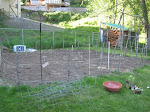It was captured by Jordan in 1948 and recaptured by Israel during the Six-Days War in 1967. It was then that they built the large plaza in front of the wall to be used for prayers. Jews and pilgrims gather here to pray and to write their prayers on pieces of paper that are then stuffed in the cracks of the stones. The area is divided into two sections, one for men and one for women. The men's section also has an indoor portion just to the left at Wilson's arch, 25-feet now but originally 75 feet high! We had time there to reflect and/or pray.
the women's section
prayers written on slips of paper
provided head coverings for the men's section
The exposed section of wall measures about 262 feet. A series of tunnels were explored by British explorers Charles Wilson, in 1864, and Charles Warren, in 1867-1870. These tunnels follow the original ground-level wall from the time of Jesus for about 1050 feet!
This area is called the Great Bridge and where the priests entered the Temple.
this looks down on 2000 year old steps
You felt as if you were walking somewhere ancient old...
a mezuzah hanging on the wall near some steps,
it contains a copy of the shema
Next we came to the Master Course, the place where the largest four stones are to provide a strong base and to help protect against earthquakes. The largest of these stones is 44 feet long, 10-11 feet high, 12-16 feet deep and weighs 570 tons! The largest stone used in the Great Pyramid weighs a mere 11 tons.
Warren's Gate is the spot nearest to the Foundation Stone of the Temple Mount and the closest spot to the Holy of Holies. It is now the site of a small women's prayer section.
The Narrow Passageway has sections of glass floors where you can see stones that the Romans threw down during the destruction of the Temple in 70AD.
Some places were low and narrow and others went up so high and yet are still so far below the Old City.
This is where we walked on an actual market street from Jesus' time and very likely a place where Jesus would have walked.
There was also a small quarry where stones were mined for the Wall and you can still see dressed natural rock.
Archaeologists believe that this aqueduct was built during the Hasmonean period and ceased being used once the Wall was built.
The Strouthion Pool was the reservoir used by Jerusalem residents for drinking and cooking water. It is 175 feet long but only 1/3 of it can be seen in the tunnels, the rest is under the Sisters of Zion monastery. Although it is very large, it was the smallest pool in Jerusalem during the Second Temple Period and is named after a small bird in Greek.
We didn't get back to the hotel until 10:00! I think it was our longest day of the entire trip.

































No comments:
Post a Comment